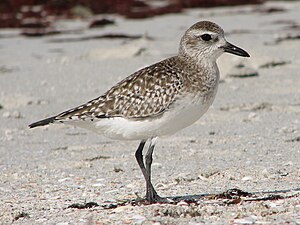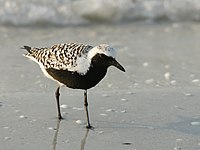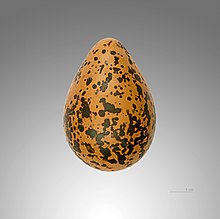Lapwing Ringed Plover
| Lapwing Ringed Plover | ||||||||||
|---|---|---|---|---|---|---|---|---|---|---|

Lapwing Ringed Plover ( Pluvialis squatarola ) |
||||||||||
| Systematics | ||||||||||
|
||||||||||
| Scientific name | ||||||||||
| Pluvialis squatarola | ||||||||||
| ( Linnaeus , 1758) |
The Gray Plover ( Pluvialis squatarola ) is a species of bird from the family of Plover (Charadriidae). It breeds in the arctic tundra. The wading bird with its strikingly high-contrast plumage occurs during its migration period in Central Europe. The lapwing ringed plover is also a sparse summer visitor at the North Sea.
description
Lapwing ringed plovers are 26 to 29 cm tall and weigh 170 to 320 g. The wingspan is 56 to 63 cm. Overall, the species is larger, stockier and longer-legged than the other plover species. The lapwing ringed plover also has a thicker head and a more powerful black beak.
The feathers in the plumage solid black colored black at the bottom and on the top with white Endsäumen. These light hems make the top of the body appear silver-gray overall. Black axillary feathers can be seen in flight.
In the plain dress worn in winter, the drawing on the upper side is less clear and also slightly sand-colored, the underside of the torso is whitish, the chest, the crown, the back of the head and the cheeks are colored sand-colored and the flanks are mottled light brown. Only parts of the light stripe above the eye and an elongated, light spot behind the cheek can be seen of the high-contrast gorgeous dress.
The short beak and eyes are dark, the legs are gray in color. The lapwing plover can live up to 18 years.
His call sounds something like "peep".
habitat
The lapwing ringed plover is a solitary species and breeds mainly in the arctic lowland tundra . The distribution area extends from the east coast of the White Sea to northeast Siberia and from Alaska to Baffin Island. During the winter half-year it spends time on the coasts of the sea on vast areas of mud and sandy beaches. It can only occasionally be seen inland in Europe, where it is usually found in reservoirs and sewage fields.
On the coasts of Central Europe , it can usually be seen at migration time. Lapwing ringed plovers are long-distance migrants that overwinter on the sea coasts of northwest Europe, the west of the North Sea to the south of Africa, on the Mediterranean and the southern coasts of Asia as well as in the coastal areas of Oceania, Australia, New Zealand, North and South America. Individual ring finds document migration distances of up to 8,650 kilometers. Lapwing ringed plovers leave their breeding grounds around August. Birds that hibernate in South Africa leave this region between March and May. On the North Sea coast they can be seen during their retreat, especially in April.
nutrition
The lapwing plover feeds on worms , crustaceans , snails , insects and their larvae . It locates its prey mostly visually, whereby it can remain motionless for a few seconds before looking for a new spot or pouncing on a prey. In contrast to the golden plover , rapid trampling of the feet is not observed in the lapwing plover . Washing the prey is typical of the lapwing ringed plover. He often grabs mussels by the siphon and then jerks them out of the shell. Crabs are chopped into pieces. Occasionally it is observed that it defends a feeding ground even in winter.
Reproduction
The sexual maturity occurs after two years. The breeding season extends from June to July. The nest is a hollow, usually on a hill , which is padded with grass and stalks . The female lays four eggs and warms them for four weeks until the chicks hatch. The young birds fledge after five to six weeks.
Lapwing ringed plovers show a high degree of loyalty to their breeding site, although this is more pronounced in the males than in the females.
supporting documents
literature
- Hans-Günther Bauer, Einhard Bezzel , Wolfgang Fiedler (eds.): The compendium of birds in Central Europe: Everything about biology, endangerment and protection. Volume 1: Nonpasseriformes - non-sparrow birds. Aula, Wiebelsheim, 2005, ISBN 3-89104-647-2 .
- Simon Delany, Derek Scott, Tim Dodman, David Stroud (Eds.): An Atlas of Wader Populations in Africa and Western Eurasia. Wetlands International , Wageningen 2009, ISBN 978-90-5882-047-1 .
- L. Svensson, PJ Grant, K. Mullarney, D. Zetterström: The new cosmos bird guide - All species of Europe, North Africa and the Middle East. Franckh-Kosmos Verlags-GmbH & Co., Stuttgart 1999, ISBN 3-440-07720-9 .
Web links
- Pluvialis squatarola in the endangered Red List species the IUCN 2008. Posted by: BirdLife International, 2008. Accessed January 30 of 2009.
- Videos, photos and sound recordings of Pluvialis squatarola in the Internet Bird Collection
- Feathers of the lapwing plover


